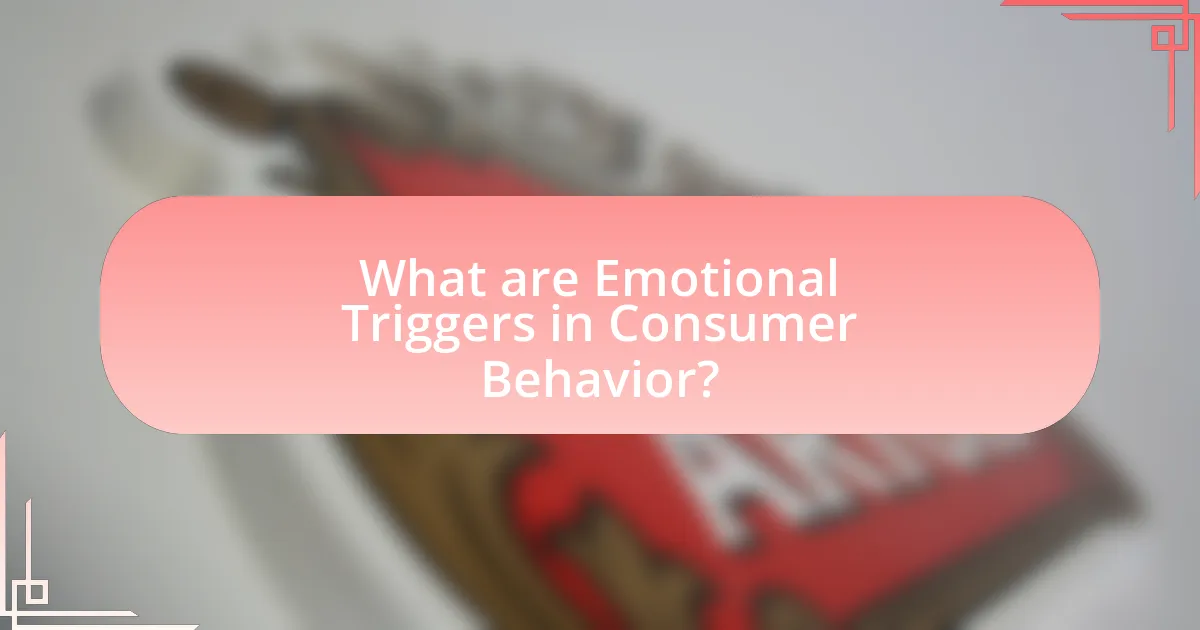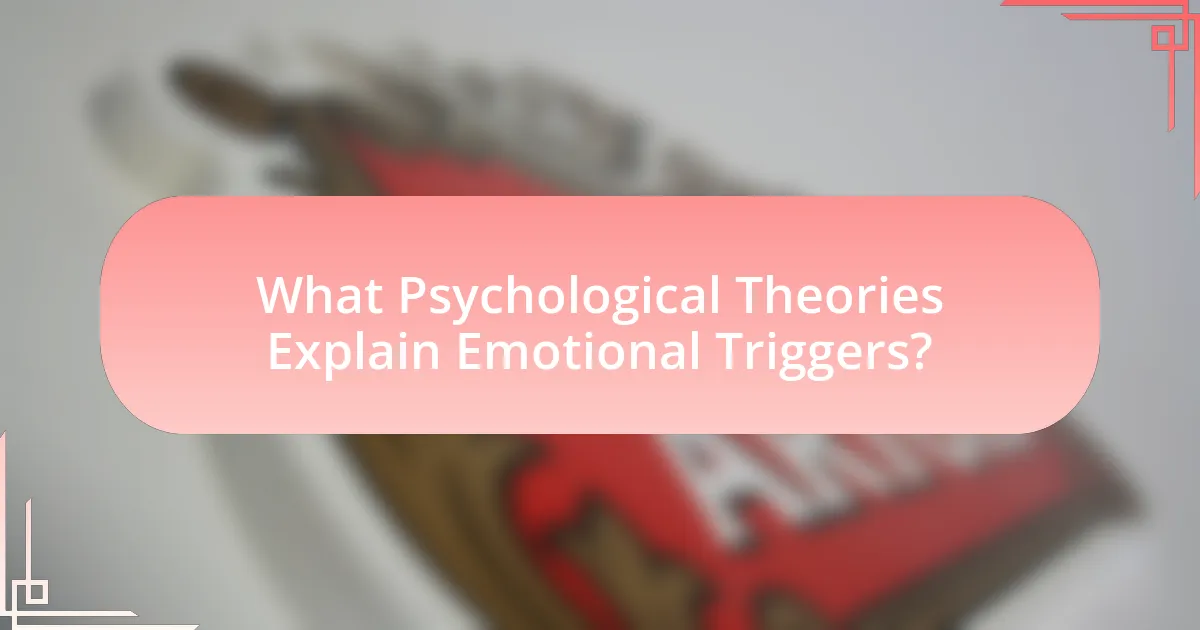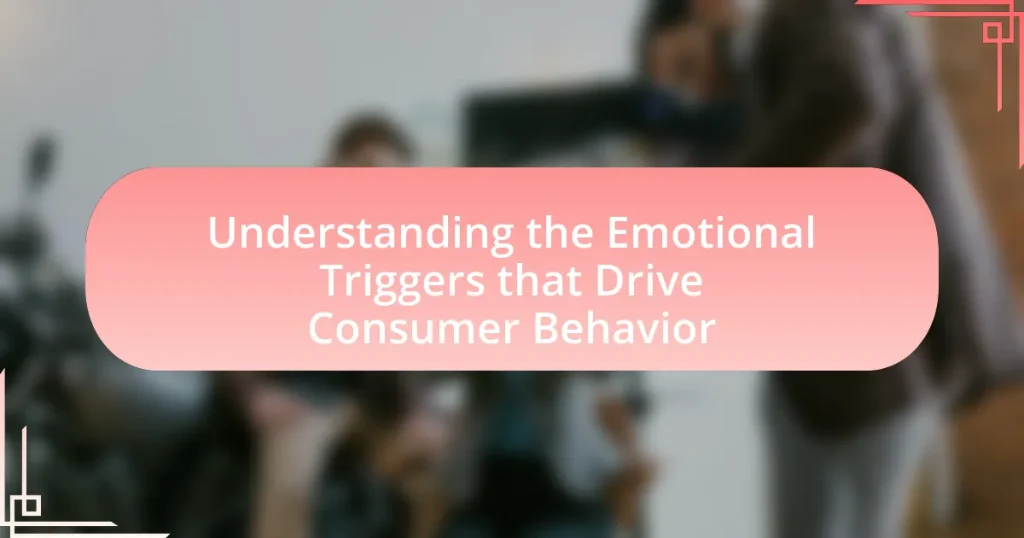Emotional triggers in consumer behavior are psychological stimuli that elicit specific emotional responses, significantly influencing purchasing decisions. This article explores how emotions such as happiness, fear, nostalgia, and urgency affect consumer trust and loyalty, highlighting the importance of emotional intelligence in marketing strategies. It discusses various methods for identifying emotional triggers, including data analytics, surveys, and social media analysis, and outlines practical strategies businesses can implement to leverage these triggers effectively. Understanding these emotional dynamics is crucial for marketers aiming to enhance consumer engagement and drive sales.

What are Emotional Triggers in Consumer Behavior?
Emotional triggers in consumer behavior are psychological stimuli that evoke specific emotional responses, influencing purchasing decisions. These triggers can include feelings of happiness, fear, nostalgia, or urgency, which marketers leverage to create connections with consumers. For instance, a study by the Journal of Consumer Research found that advertisements that evoke emotions can increase consumer engagement and brand loyalty, demonstrating the significant impact of emotional triggers on buying behavior.
How do emotional triggers influence purchasing decisions?
Emotional triggers significantly influence purchasing decisions by affecting consumers’ feelings and perceptions about products. When consumers experience emotions such as happiness, fear, or nostalgia, these feelings can lead to impulsive buying or brand loyalty. For instance, a study published in the Journal of Consumer Research found that advertisements evoking positive emotions can increase purchase intentions by up to 50%. This demonstrates that emotional responses can create a strong connection between consumers and brands, ultimately driving sales.
What types of emotions are most commonly triggered in consumers?
The types of emotions most commonly triggered in consumers include happiness, fear, sadness, and anger. Happiness often arises from positive experiences, such as receiving a discount or enjoying a product, which can enhance customer loyalty. Fear is frequently triggered by scarcity tactics, such as limited-time offers, prompting consumers to act quickly to avoid missing out. Sadness can be evoked through storytelling in marketing that resonates with consumers’ personal experiences, leading to a deeper emotional connection with the brand. Anger may occur when consumers feel misled or experience poor service, which can negatively impact brand perception. These emotional triggers are supported by research indicating that emotions significantly influence purchasing decisions, as demonstrated in studies like “The Role of Emotion in Consumer Behavior” by authors such as Paul Ekman and others, which highlight the impact of emotional responses on consumer actions.
How do different emotions affect consumer trust and loyalty?
Different emotions significantly influence consumer trust and loyalty, with positive emotions generally enhancing both, while negative emotions can diminish them. For instance, research indicates that feelings of happiness and satisfaction lead to increased trust in brands, as consumers perceive them as more reliable and credible. A study published in the Journal of Consumer Research by authors such as J. M. Aaker and D. A. Stayman found that positive emotional experiences with a brand can foster long-term loyalty, as consumers are more likely to return to brands that evoke joy or contentment. Conversely, emotions like anger or disappointment can lead to distrust and a decrease in loyalty, as consumers may feel betrayed or dissatisfied with their experiences. Thus, the emotional state of consumers plays a crucial role in shaping their perceptions of trustworthiness and their commitment to brands.
Why are emotional triggers important for marketers?
Emotional triggers are important for marketers because they significantly influence consumer decision-making and purchasing behavior. Research indicates that emotions drive 70% of purchasing decisions, highlighting the necessity for marketers to connect with consumers on an emotional level. By leveraging emotional triggers, such as fear, joy, or nostalgia, marketers can create compelling narratives that resonate with their target audience, leading to increased engagement and brand loyalty. For instance, a study published in the Journal of Consumer Research found that advertisements evoking emotional responses are more likely to be remembered and shared, demonstrating the effectiveness of emotional marketing strategies.
How can understanding emotional triggers improve marketing strategies?
Understanding emotional triggers can significantly enhance marketing strategies by enabling brands to create more resonant and impactful messaging. When marketers identify and leverage specific emotional triggers, they can tailor their campaigns to evoke desired feelings, leading to increased consumer engagement and loyalty. For instance, research by the Nielsen Company indicates that ads that evoke strong emotions can lead to a 23% increase in sales compared to those that do not. By aligning marketing efforts with the emotional states of their target audience, brands can foster deeper connections, ultimately driving conversions and enhancing brand perception.
What role do emotional triggers play in brand perception?
Emotional triggers significantly influence brand perception by shaping consumers’ feelings and attitudes towards a brand. When brands evoke emotions such as happiness, nostalgia, or trust, they create a deeper connection with consumers, leading to increased loyalty and preference. Research indicates that emotionally connected customers are more likely to recommend a brand and make repeat purchases, as demonstrated by a study from the Harvard Business Review, which found that emotionally engaged customers are three times more likely to recommend a brand and five times more likely to purchase again. This highlights the critical role emotional triggers play in enhancing brand perception and driving consumer behavior.

What Psychological Theories Explain Emotional Triggers?
Psychological theories that explain emotional triggers include the James-Lange Theory, Cannon-Bard Theory, and the Schachter-Singer Theory. The James-Lange Theory posits that emotions arise from physiological responses to stimuli; for instance, seeing a snake may cause a racing heart, leading to the feeling of fear. The Cannon-Bard Theory argues that emotional experiences and physiological reactions occur simultaneously but independently; thus, one can feel fear while simultaneously experiencing a racing heart. The Schachter-Singer Theory, also known as the Two-Factor Theory, suggests that emotion is based on physiological arousal and cognitive labeling of that arousal; for example, if a person feels their heart racing and labels the situation as dangerous, they will experience fear. These theories provide a framework for understanding how emotional triggers can influence consumer behavior by linking physiological responses and cognitive interpretations to emotional experiences.
How does the theory of emotional intelligence relate to consumer behavior?
The theory of emotional intelligence relates to consumer behavior by influencing how consumers perceive, evaluate, and respond to marketing stimuli. Emotional intelligence enables consumers to recognize their own emotions and the emotions of others, which affects their decision-making processes. For instance, research indicates that consumers with higher emotional intelligence are better at interpreting emotional cues in advertisements, leading to more favorable attitudes toward brands and products. A study published in the Journal of Consumer Research found that emotionally intelligent consumers are more likely to engage with brands that resonate with their feelings, ultimately driving purchasing behavior.
What are the key components of emotional intelligence in marketing?
The key components of emotional intelligence in marketing are self-awareness, self-regulation, empathy, social skills, and motivation. Self-awareness allows marketers to understand their own emotions and how these affect their marketing strategies. Self-regulation helps in managing emotions to maintain professionalism and adapt to changing market conditions. Empathy enables marketers to connect with consumers by understanding their feelings and needs, which is crucial for creating targeted campaigns. Social skills facilitate effective communication and relationship-building with customers, enhancing brand loyalty. Motivation drives marketers to pursue goals and inspire others, leading to innovative marketing solutions. These components collectively enhance a marketer’s ability to engage consumers and influence their purchasing decisions.
How can marketers leverage emotional intelligence to connect with consumers?
Marketers can leverage emotional intelligence by understanding and responding to consumers’ emotional needs and triggers. This involves actively listening to consumer feedback, analyzing emotional responses to marketing campaigns, and tailoring messages that resonate on a personal level. Research indicates that emotionally intelligent marketing can increase customer loyalty; for instance, a study by the Harvard Business Review found that emotionally connected customers are more than twice as valuable as highly satisfied customers. By utilizing emotional intelligence, marketers can create deeper connections, foster brand loyalty, and ultimately drive sales.
What is the role of the subconscious in emotional triggers?
The subconscious plays a crucial role in emotional triggers by influencing automatic responses to stimuli without conscious awareness. This influence occurs through learned associations and past experiences stored in the subconscious, which can evoke strong emotional reactions when similar situations arise. For example, a study published in the Journal of Consumer Research by authors such as John Bargh demonstrates that subconscious cues can significantly affect consumer behavior, leading to impulsive purchasing decisions based on emotional triggers rather than rational thought.
How do subconscious emotions influence consumer choices?
Subconscious emotions significantly influence consumer choices by shaping preferences and decision-making processes without conscious awareness. Research indicates that emotions, such as fear, joy, or nostalgia, can trigger automatic responses that affect purchasing behavior. For instance, a study published in the Journal of Consumer Research found that consumers often make choices based on emotional associations rather than rational evaluations, demonstrating that feelings can override logical reasoning. This emotional influence is evident in marketing strategies that evoke specific feelings to create brand loyalty and drive sales, as consumers are more likely to choose products that resonate with their emotional states.
What techniques can marketers use to tap into subconscious triggers?
Marketers can use techniques such as emotional storytelling, sensory marketing, and social proof to tap into subconscious triggers. Emotional storytelling engages consumers by creating relatable narratives that evoke feelings, which can influence purchasing decisions. Sensory marketing appeals to the senses—sight, sound, smell, taste, and touch—creating memorable experiences that can lead to brand loyalty; for example, studies show that scents can increase recall and preference for a brand. Social proof leverages the influence of others’ behaviors and opinions, as demonstrated by research indicating that consumers are more likely to trust and follow the actions of their peers, enhancing the perceived value of a product.

How Can Businesses Identify Emotional Triggers in Their Audience?
Businesses can identify emotional triggers in their audience by utilizing data analytics, surveys, and social listening tools. Data analytics allows companies to analyze consumer behavior patterns and preferences, revealing emotional responses to specific products or marketing campaigns. Surveys can directly ask consumers about their feelings and motivations, providing qualitative insights into emotional triggers. Social listening tools monitor online conversations and sentiments, helping businesses understand how their audience emotionally engages with their brand and competitors. Research indicates that 70% of consumers are more likely to purchase from brands that understand their emotional needs, highlighting the importance of identifying these triggers for effective marketing strategies.
What methods can be used to research consumer emotions?
Surveys and interviews are effective methods to research consumer emotions. Surveys can quantify emotional responses through structured questions, while interviews provide qualitative insights into consumer feelings and motivations. For instance, a study by the Journal of Consumer Research found that emotional responses significantly influence purchasing decisions, highlighting the importance of understanding these emotions in consumer behavior. Additionally, techniques such as focus groups and observational studies can further reveal emotional triggers by analyzing group dynamics and real-time reactions to products or marketing stimuli.
How can surveys and focus groups reveal emotional triggers?
Surveys and focus groups can reveal emotional triggers by collecting qualitative and quantitative data on consumer feelings and reactions. Surveys often include questions designed to gauge emotional responses to specific products, brands, or marketing messages, allowing researchers to identify patterns in how emotions influence purchasing decisions. Focus groups provide a platform for in-depth discussions, where participants can articulate their feelings and experiences, revealing underlying emotional drivers that may not be captured in surveys. For example, a study published in the Journal of Consumer Research found that emotional responses significantly impact brand loyalty, demonstrating that understanding these triggers can enhance marketing strategies.
What role does social media play in understanding consumer emotions?
Social media serves as a critical tool for understanding consumer emotions by providing real-time insights into public sentiment and emotional responses. Platforms like Twitter, Facebook, and Instagram allow consumers to express their feelings about brands, products, and experiences, generating vast amounts of data that can be analyzed for emotional trends. Research indicates that 79% of consumers are influenced by social media posts when making purchasing decisions, highlighting the platform’s impact on emotional engagement. Additionally, sentiment analysis tools can quantify emotions expressed in social media interactions, enabling brands to tailor their marketing strategies based on consumer feedback and emotional triggers.
How can data analytics help in identifying emotional triggers?
Data analytics can help in identifying emotional triggers by analyzing consumer behavior patterns and sentiment data. By utilizing techniques such as sentiment analysis on social media, surveys, and customer feedback, businesses can quantify emotional responses to products or services. For instance, a study by the Journal of Consumer Research found that emotional responses significantly influence purchasing decisions, with 70% of consumers making purchases based on emotions rather than logic. This data-driven approach enables companies to pinpoint specific emotional triggers, such as joy or frustration, that drive consumer engagement and loyalty.
What types of data should businesses analyze to uncover emotional insights?
Businesses should analyze customer feedback, social media interactions, and purchase behavior data to uncover emotional insights. Customer feedback, such as reviews and surveys, provides direct expressions of feelings and satisfaction levels. Social media interactions reveal sentiments through comments, likes, and shares, indicating emotional responses to brands and products. Purchase behavior data, including frequency and timing of purchases, can highlight emotional triggers tied to specific products or marketing campaigns. Research shows that 70% of buying experiences are based on how the customer feels they are being treated, emphasizing the importance of understanding these emotional insights for effective marketing strategies.
How can sentiment analysis be applied to consumer feedback?
Sentiment analysis can be applied to consumer feedback by systematically evaluating the emotions expressed in reviews, comments, and surveys to gauge customer satisfaction and preferences. This technique utilizes natural language processing algorithms to classify feedback as positive, negative, or neutral, enabling businesses to identify trends in consumer sentiment. For instance, a study by Liu (2012) highlights that companies leveraging sentiment analysis can enhance product development and marketing strategies by understanding consumer emotions, leading to improved customer engagement and loyalty.
What practical strategies can businesses implement to leverage emotional triggers?
Businesses can implement several practical strategies to leverage emotional triggers effectively. One strategy is storytelling, which engages consumers by creating relatable narratives that evoke emotions, leading to stronger brand connections. Research shows that stories can increase information retention by up to 22 times compared to facts alone. Another strategy is utilizing social proof, such as testimonials and user-generated content, which can trigger feelings of trust and belonging, influencing purchasing decisions. Studies indicate that 79% of consumers trust online reviews as much as personal recommendations. Additionally, businesses can create urgency through limited-time offers, tapping into the fear of missing out (FOMO), which can drive immediate action. According to a study by the University of Southern California, scarcity can increase demand by up to 50%. By integrating these strategies, businesses can effectively harness emotional triggers to enhance consumer engagement and drive sales.


